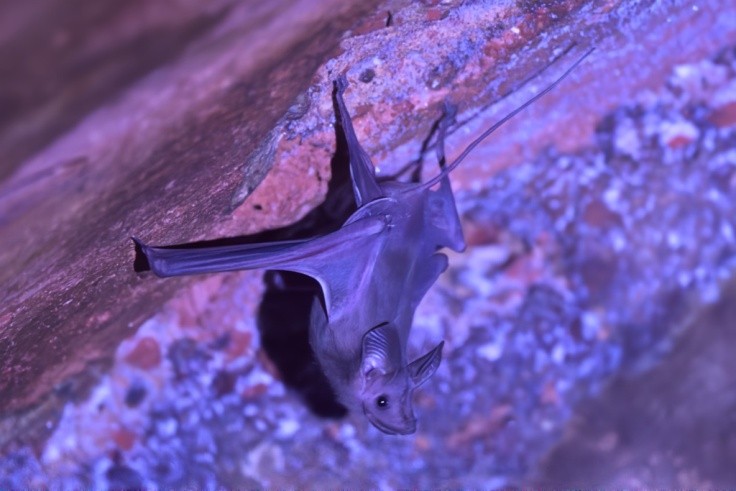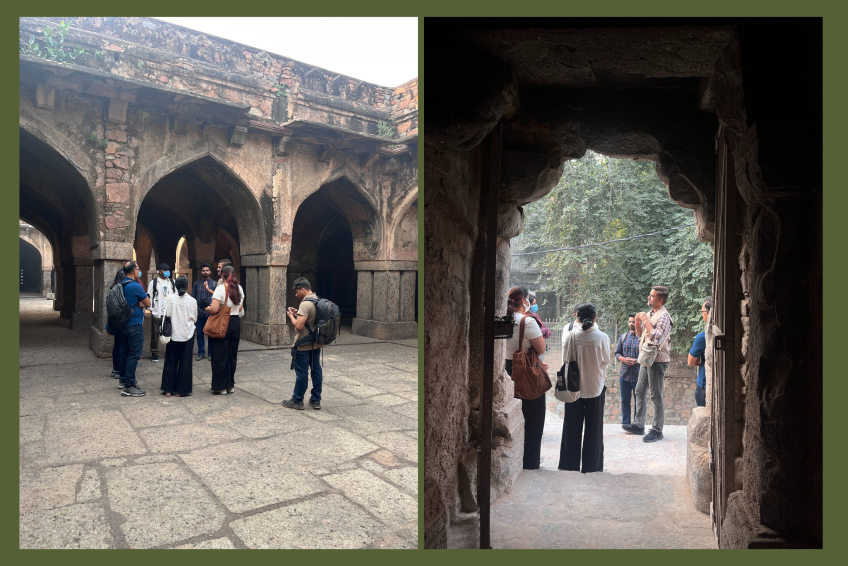Bat Walk Adventure In New Delhi: Witnessing Bats in Their Natural Habita

Compiled by:
Dr. Sumit Dookia
Wildlife Biologist & Associate Professor
University School of Environment Management
Guru Gobind Singh Indraprastha University
Sec. 16 C, Dwarka, New Delhi – 110078
Email: sumitdookia@ipu.ac.in

Walk Details
Date: 02 November 2025
Venue: Khirki Masjid, Saket, New Delhi
Timing: 8:00 AM – 10:00 AM
Number of Participants: 09
Participants Name: Anika Chadha, Shivani wadehra, Hannah K, Ashish C Prithvi Subba, Ardas Mehta,
Kunal Mehta, Ishika, Sonal
Walk Leader: Dr. Sumit Dookia
Organised by: Earth Walks by Asian Adventures & Global Wildlife Fair
1. Introduction
Delhi, India’s vibrant capital, is home to millions of species — humans being just one among them. This reality underscores the fact that we share our space with numerous other forms of life, many of which remain unseen or undiscussed in daily urban life. Among these fascinating yet overlooked creatures are bats — the only true flying mammals of our night skies.
Bats (Order Chiroptera) represent one of the most diverse and ecologically significant groups of mammals, comprising over 140 species in India. Despite their critical ecological roles in insect control, pollination, and seed dispersal, they remain one of the most misunderstood animal groups, often associated with superstition or fear rather than scientific curiosity.
Bat species prefer dark, humid, and quiet environments, often away from human sight during the day. Delhi’s landscape, dotted with ancient monuments and tombs, provides such conditions in abundance. The old architectural heritage of Delhi — stepwells, mosques, forts, and tombs — serve as ideal roosting habitats for various bat species, functioning much like natural caves.
On 2nd November 2025, nine enthusiastic participants joined me for an immersive walk titled “Behaviour of Bats”, organized under the Delhi Earth Walk initiative by Global Wildlife Fair and Asian Adventures. The objective was to foster awareness, appreciation, and scientific understanding of urban bat ecology through firsthand observation. Having studied bats for over two decades and documented hundreds of roosting sites across northern India, I aimed to bridge the gap between scientific knowledge and public awareness.
Urban areas often overlook nocturnal wildlife such as bats, yet these creatures play vital ecological roles. Delhi provides an especially interesting case of bat-fauna coexisting within heritage architecture amidst rapid urbanization. This report combines the findings of the bat walk and scientific observations on the status, diversity, threats, and conservation strategies for bats in Delhi.
2. Objectives
- To introduce participants to the diversity and ecological roles of bats in urban environments.
- To observe and document roosting bat species within the Khirki Masjid premises.
- To understand the behavioural and morphological adaptations of various bat species.
- To discuss conservation challenges and strategies for protecting bats in urban and semi-urban landscapes.
3. Methodology
The walk began at 8:00 AM with an orientation session on the taxonomy, classification, and ecological importance of bats. Participants explored the interior of Khirki Masjid, guided through dark chambers and stone vaults where bat colonies roost.
Observations were made visually and aurally, using binoculars and red-light torches to minimize disturbance. Behavioural notes — such as clustering, grooming, roosting posture, and signs of flight emergence — were recorded to understand species-specific ecology.
The chosen site, a 14th-century Tughlaq-era mosque, offers dark chambers, high ceilings, and stable microclimatic conditions, analogous to caves. These architectural traits make it an ideal microhabitat for urban bats.
4. Status of Bat Fauna in Delhi
4.1 Species Diversity and Recent Records
- Earlier studies (2007) recorded 13 species of bats in Delhi.
- Recent media and field records suggest 15 species now inhabit the capital, including two newly recorded since 2018.
- Some older species have not been recently detected, suggesting local extinctions.
Newly recorded species include:
- Scotophilus kuhlii (Lesser Yellow House Bat), recorded roosting in building ducts in 2018.
- Otomops wroughtoni (Wroughton’s Free-tailed Bat), discovered in Yamuna Biodiversity Park in December 2024, marking its first record for Delhi.
4.2 Role of Old Monuments as Roost Sites
A landmark study, “The Monumental Mistake of Evicting Bats from Archaeological Sites—A Reflection from New Delhi” (Umadi et al. 2019), documented bats roosting across five archaeological monuments:
Agrasen ki Baoli
- Khirki Mosque
- Feroz Shah Kotla Mosque
- Qutb Minar Complex
- Zafar Mahal
These monuments provide dark vaults and crevices that replicate natural cave conditions, making them critical long-term roosting habitats. The authors note that bats may have inhabited such structures for centuries, highlighting their ecological and historical significance.
5. Species Documented During the Walk
1. Mouse-tailed Bat (Rhinopoma microphyllum)
- Family: Rhinopomatidae
- Common Name: Greater Mouse-tailed Bat
- Identification: Long, slender tail extending beyond the membrane; large ears joined at the base.
- Ecology: Prefers arid roosts in tombs and tunnels; observed in Khirki’s domes.
- Behaviour: Insectivorous; hunts at dusk with low-intensity echolocation.
- Status: Least Concern (IUCN) but sensitive to disturbance.

2. Fulvous Fruit Bat (Rousettus leschenaultii)
- Family: Pteropodidae
- Common Name: Leschenault’s Rousette / Fulvous Fruit Bat
- Identification: Medium-sized, fulvous-brown fur, large eyes for low-light vision.
- Ecology: Roosts in groups under arches; contributes to pollination and seed dispersal.
- Unique Feature: Uses tongue-click echolocation, rare among fruit bats.
- Status: Least Concern (IUCN) but threatened by habitat loss.
3. Naked-rumped Tomb Bat (Taphozous nudiventris)
- Family: Emballonuridae
- Identification: Naked patch on lower back; narrow wings for fast flight.
- Ecology: Occupies ventilated crevices; observed in Khirki’s open cavities.
- Behaviour: Insectivorous, foraging in open areas; prefers warm roosts.
- Status: Least Concern (IUCN) yet vulnerable to loss of urban roosts.

6. Discussion
Khirki Masjid offers an exceptional case study of how Delhi’s heritage monuments function as urban refuges for bats.
Different species occupy distinct niches — Rhinopoma in crevices, Rousettus in shaded chambers, Taphozous in ventilated spaces — demonstrating microhabitat partitioning and reduced interspecific competition.
Dr. Dookia elaborated on evolutionary adaptations such as wing morphometrics, echolocation, and roost fidelity. The session dispelled common misconceptions linking bats with disease, emphasizing their ecological importance in controlling insect populations and maintaining seed dispersal across fragmented ecosystems.
Participants expressed enthusiasm and curiosity, realizing that bats are vital ecosystem engineers, not creatures to fear.
7. Current Threats and Concerns
7.1 Habitat and Roost Loss
Urbanization, monument restoration, and lighting installations often seal crevices and displace colonies. For instance, ASI’s renovation at Khirki Mosque included mesh screening to block bats due to droppings — a well-intentioned but ecologically damaging move.
7.2 Disturbance and Artificial Lighting
Artificial lighting disrupts the darkness bats depend upon. Noise, tourism, and cleaning activities alter microhabitats. When displaced, bats lose foraging efficiency, and the city loses a natural insect-control mechanism.
7.3 Local Extirpations
Several species — Megaderma lyra, Taphozous melanopogon, Tadarida aegyptiaca, Pipistrellus coromandra — may be locally extinct, indicating a decline in habitat quality and ecosystem function.
8. Conservation and Heritage Integration
8.1 Ecosystem Services
Insectivorous bats consume vast quantities of pests nightly, offering natural pest control and economic value to agriculture. Their presence within monuments thus supports heritage-linked biodiversity.
8.2 Conservation Recommendations
- Conduct seasonal bat surveys before restoration projects.
- Retain dark crevices and roosting spaces during renovations.
- Adopt bat-friendly lighting and minimize direct illumination.
- Preserve foraging corridors and nearby vegetation.
- Promote education and guided bat walks to shift public perception from fear to fascination.
- Foster inter-agency collaboration between ASI, wildlife authorities, and civic
- bodies to align heritage management with biodiversity conservation.
9. Conclusion
The Behaviour of Bats Walk was a scientifically enriching and awareness-driven experience, connecting participants with the nocturnal biodiversity of Delhi. The observation of three distinct bat species in a single urban monument underscores the city’s untapped potential for urban wildlife conservation.
Integrating bat protection into heritage management can create synergistic outcomes — preserving both built and biological heritage while advancing the Sustainable Development Goals related to biodiversity and education.
Continued research, awareness campaigns, and community-based initiatives like Earth Walks and Global Wildlife Fair can ensure Delhi remains a city where heritage and wildlife thrive together.

10. References
- Umadi R., Dookia S., Rydell J. “The Monumental Mistake of Evicting Bats from Archaeological Sites—A Reflection from New Delhi.” Heritage. 2019;2(1):553–567.
- Rare Bat Species Spotted in Delhi – ThePrint, Oct 2025.
- Delhi’s Bat Population on a Steep Decline, Here’s Why – Jeevoka Buzz, Sept 2023.
- Khirki Masjid to Get Bat Protection Cover – The Times of India.
- Delhi Is Now Home to a Bat Species Never Seen Before in City – India Today, Apr 2018.
